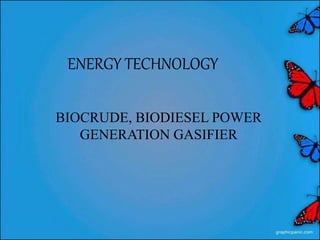
Biocrude and gasification
- 1. ENERGY TECHNOLOGY BIOCRUDE, BIODIESEL POWER GENERATION GASIFIER
- 2. • Biomass origin - Resources – Biomass estimation. • Thermo chemical conversion – Biological conversion, Chemical conversion • Hydrolysis & hydrogenation, solvolysis, biocrude, biodiesel power generation gasifier, biogas, integrated gasification. UNIT 4-BIOMASS ENERGY
- 3. BIOCRUDE • Bio-crude, sometimes also known as Pyrolysis oil or bio-oil, is a synthetic fuel under investigation as substitute for petroleum. • It is obtained by heating dried biomass without oxygen in a reactor at a temperature of about 500 °C with subsequent cooling. • Pyrolysis oil is a kind of tar and normally contains levels of oxygen too high to be considered a pure hydrocarbon.
- 4. BIOCRUDE • This high oxygen content results in non- volatility, corrosiveness, immiscibility with fossil fuels, thermal instability, and a tendency to polymerize when exposed to air. • As such, it is distinctly different from petroleum products. • Removing oxygen from bio-oil or nitrogen from algal bio-oil is known as upgrading.
- 5. BIOCRUDE • Pyrolysis is a well established technique for decomposition of organic material at elevated temperatures in the absence of oxygen into oil and other constituents. In second-generation bio fuel applications • Forest and agricultural residues, waste wood, yard waste, and energy crops can be used as feedstock.
- 6. WOOD PYROLYSIS • When wood is heated above 270 °C it begins a process of decomposition called carbonization. • In the absence of oxygen, the final product is charcoal. If sufficient oxygen is present, the wood will burn when it reaches a temperature of about 400- 500 °C and the catch fire and fuel product is wood ash. • If wood is heated away from air, the moisture is first driven off and until this is complete, the wood temperature remains at about 100-110 °C.
- 7. WOOD PYROLYSIS • When the wood is dry its temperature rises, and at about 270 °C it begins to spontaneously decompose and generate heat. • This is the well known exothermic reaction which takes place in the burning of charcoal. • At this stage evolution of carbonization by-products starts. • These substances are given off gradually as the temperature rises and at about 450 °C the evolution is complete.
- 8. WOOD PYROLYSIS • The solid residue, charcoal, is mainly carbon (about 70%), with the remainder being tar-like substances • Which can be decomposed completely only by raising the temperature to above about 600 °C to produce Biochar, a high-carbon, fine-grained residue that today is produced through modern process. • Which is the direct thermal decomposition of biomass in the absence of oxygen, which prevents combustion, to obtain an array of solid (biochar), liquid—Pyrolysis oil (bio-oil/pyrolysis-oil), and gas (syngas) products.
- 10. ALGAL PYROLYSIS • Algae may be subjected to high temperatures (500 °C) and normal atmospheric pressures. • The resultant products include oil and nutrients such as nitrogen, phosphorus, and potassium. • The most common method, FAST PYROLYSIS involves using a volume specified container at a high temperature and controlled pressure conditions.
- 12. ALGAL PYROLYSIS • Absence of oxygen • High heat and heat transfer rates • Short vapor residence time (2-3 sec) • Rapid cooling of vapor from pyrolysis • Addition of organic carbon sources and decrease in organic nitrogen source favors fast growth. • Feed stock: Glucose(most common),pine wood and cotton straw etc.
- 13. FAST PYROLYSIS
- 14. COMPONENTS • The system comprises a mass flow controller, stainless steel pyrolysis (FB), screw feeder, cyclone, and condensers . • Nitrogen gas is preheated in the air plenum to 450–600 °C before injecting to the reactor. • A distributor is installed at the bottom of the reactor. • Fluidized bed is heated by electric field. • The condenser works with refrigerants which is recirculated by a chiller system. • The gas was sampled by a gas sampler.
- 15. Advantages • Bio-based fuel with essentially carbon neutral combustion • Drop in replacement for petroleum-based liquid fuels • Inherently renewable • Absorbs carbon dioxide as it grows • Both waste CO2 and wastewater can be used as nutrients • Higher energy per-acre than other bio-fuels • Can be grown on land unsuitable for other types of agriculture • Investments are being made
- 16. Disadvantages • Need to be grown under controlled temperature conditions • Requires a considerable amount of land and water • Cold flow issues with algal bio-fuel • Some researchers using genetic engineering to develop optimal algae strains • Requires phosphorus as a fertilizer which is becoming scarce • Relatively high upfront capital costs • Not clear yet what the ultimate cost per gallon will be. Presently too high.
- 17. Algal Hydrothermal Liquefaction • Hydrothermal liquefaction (HTL) is a thermal depolymerization process used to convert wet biomass into crude-like oil - sometimes referred to as bio-oil or biocrude- under moderate temperature and high pressure. • The crude-like oil (or bio-oil) has high energy density with a lower heating value of 33.8-36.9 MJ/kg and 5-20 wt% oxygen and renewable chemicals
- 19. PROCESS VARIABLE • Most applications of hydrothermal liquefaction operate at temperatures between 250-550oC and high pressures of 5-25 MPa as well as catalysts for 20–60 minutes • Feedstock composition • Temperature and heating rate • Pressure • Solvent • Residence time • Catalysts-Water, Salts, including KOH and Na2CO3 • The HTL process differs from pyrolysis as it can process wet biomass and produce a bio-oil that contains approximately twice the energy density of pyrolysis oil.
- 20. Flow diagram